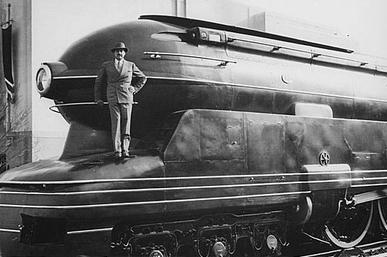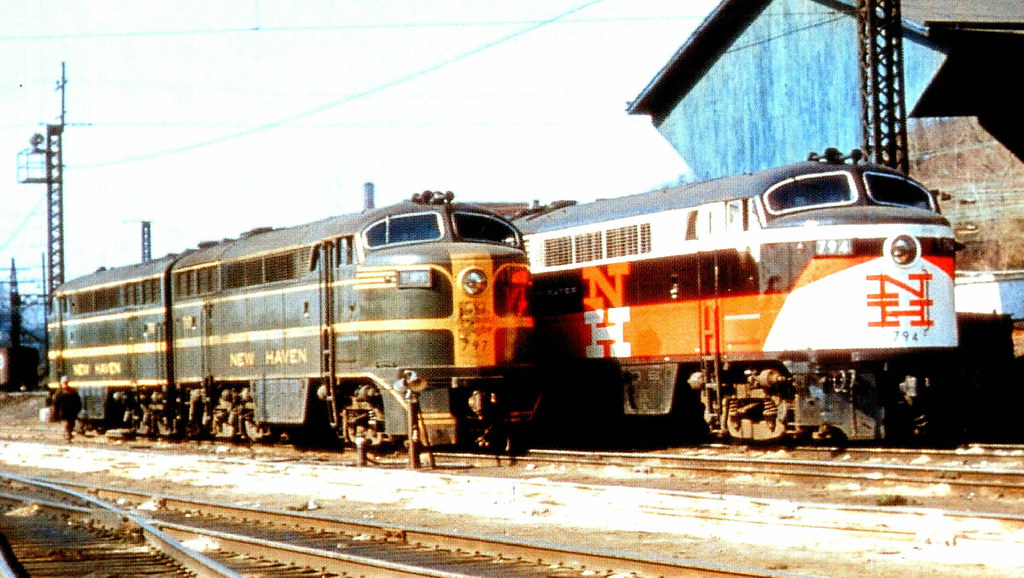Raymond Loewy was an industrial designer who would be celebrating his 120th birthday if he were still alive today. While he was not a railroad man, we have chosen to talk about him because his industrial design work did have an influence in the railroad industry.
Loewy was born in France on November 5, 1893, and he was educated at the University of Paris. Most of his design work however was in the United States. In the railroad industry, he had a close relationship with the Pennsylvania Railroad, beginning in 1937. His best known railroad designs were for their passenger locomotives. He is most often connected to the GG1 electric locomotive, although it should be noted that he did not actually design the locomotive. He suggested that the locomotive body be welded, to improve the overall appearance, and he designed the pinstripe paint scheme that many of them wore, highlighting the shape and contours of the locomotive.
 |
PRR K4 Pacific #3768
Image from Wikipedia. |
Loewy did design a number of locomotives for the Pennsylvania Railroad. In 1938, one of his earliest locomotive designs was a streamlined shroud for K4 steam locomotive #3768
. For some time, this locomotive pulled the
Broadway Limited. Like most steam locomotives that wore streamlined shrouds, the metal casing covered many of the mechanical components of the locomotive, making access for maintenance and repairs difficult. Eventually the railroad determined that the shroud proved to be too much trouble, and it was removed from the locomotive.
 |
Loewy poses on the S1 Class locomotive.
Image from Wikipedia |
In 1939, the Pennsylvania Railroad completed the experimental S1 class locomotive. Only one locomotive was produced, and it too featured a streamlined shroud, designed by Loewy. The S1 was originally intended to replace the Pennsylvania's fleet of aging K4 locomotives. The mechanical aspects of the locomotive were designed as a joint effort between the Pennsylvania Railroad, Lima Locomotive Works, American Locomotive Works, and Baldwin Locomotive Works. The Pennsylvania Railroad had hoped it would have the same performance and success as their GG1 locomotives. In the end however, it proved to be too big. It was the longest rigid frame steam locomotive ever built, and it had trouble negotiating some of the curves on the PRR. There were also problems with wheelslip and clearances. The locomotive was scrapped in 1949, and the railroad began to focus more on the T1 class steam locomotives.
 |
A T1 class locomotive at the Baldwin plant, prior to
delivery to the PRR.
Image from Wikipedia. |
In 1942, the Pennsylvania Railroad introduced its last steam locomotive, the T1 class. The T1 class locomotives were designed to be fast passenger locomotives. While very impressive locomotives technologically, they proved to be difficult to maintain. They were designed to operate at speeds up to 100 mph, although high speeds cause excessive wear and tear on valves, resulting in higher maintenance costs. They were so powerful that if the engineer was not careful, violent wheelslip could occur even at 100 mph. The T1 class was said to be "free steaming" locomotives, meaning the boiler was capable of producing more steam than the locomotive consumed at any throttle setting. The streamlined shell of the T1 class locomotives became known as a "Sharknose," and was designed by Loewy. The shroud on the T1 class left more of the running gear exposed, and allowed slightly better maintenance access than streamlining had on earlier locomotives.
After the T1 class locomotives, the Pennsylvania Railroad began to shift its focus to diesel, and eventually all passenger trains were pulled by diesel locomotives. Loewy redesigned many of the railroad's Baldwin diesels, and gave them a "sharknose" appearance similar to that of the T1 class steam locomotives. Besides locomotives, Loewy also did other design work for the Pennsylvania Railroad, which included marketing materials, passenger car interiors, and several station.
 |
New Haven C-Liner locomotives.
Image from Flikr user torinodave72 |
Outside of the Pennsylvania Railroad, Loewy did design work for other railroads and other locomotive builders. In the late 1940's, Loewy worked with Fairbanks-Morse in the design of some of their new diesel locomotives, including the "Erie-built," the "C-Liner," and several others. In 1949, he also designed the Norfolk & Western Railway's new Roanoke, VA, station, which is now the home of the O. Winston Link Museum.
The railroad industry made up only a small portion of Loewy's work. Within the transportation industry, he also did extensive design work for Studebaker, designing a new corporate logo and some of the elements of their automobiles. He also designed the TWA logo in 1959 and the interior of Air France's Concorde in 1975. NASA's
Skylab station was also a Loewy design. Outside the transportation industry, he also did work for Macy's, Saks, Sears-Roebuck, and many other firms. He also redesigned the Coca-Cola bottle and later designed their first steel soda cans. The Air Force One livery and the Coast Guard's "racing stripe" service mark were also Loewy designs. For a full list of his designs, please visit
http://en.wikipedia.org/wiki/Raymond_Loewy#Loewy_designs.
 |
| Image from Google |
Google has honored the work of Raymond Loewy with the Google Doodle on the left. It is designed to resembles Loewy's K4 class locomotive design, using the locomotive wheels to spell out Google.







No comments:
Post a Comment